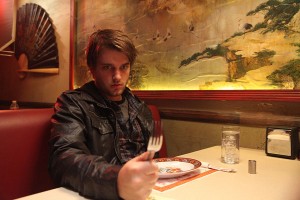John Dies strays from Wong’s material
Though plenty of odd movies have hit theaters in the recent past, audience members will be hard-pressed to find more bizarre, unexpected fare than John Dies at the End.

Seeing supernatural · Former USC student Chase Williamson plays Dave, a college dropout who learns about the mysterious powers of “soy sauce,” a street drug that allows people to see supernatural creatures. – Courtesy of Magnet Release
Written and directed by Don Coscarelli, the film, opening Jan. 25 at the Nuart Theatre, is an adaptation of David Wong’s beloved horror novel of the same name. Told in a thoroughly nonlinear fashion, the story roughly follows the misadventures of best friends Dave (USC alumnus Chase Williamson) and John (Rob Mayes), who partake in a mysterious substance called “soy sauce” that gives them the ability to see supernatural creatures and pass into other universes. Naturally, the pair uses these newfound powers to combat evil.
When creating the film, Coscarelli, who spoke at a screening of the film, noted he tended to discard the terror and favor the humor by stripping at least half of the source material, a process he referred “serious surgery.” It’s a different twist from much of his work, as Coscarelli usually finds ways to make his audience scream. Yet overall, the production more resembles a gruesome twist on Dude, Where’s My Car? than a straight horror tale.
Because the book is a tapestry of intricately woven absurdest prose providing equal parts terror and cathartic humor, loyal book fans might be horrified by the characterization. Even so, Coscarelli’s film does have its own merits. It is a genuinely entertaining romp that effectively conveys many of the most absurd plot points of the novel and successfully engages the audience in its tomfoolery.
Perhaps the most intriguing element of the novel and one of the most effectively translated storylines is the framing device, a scene in a diner between Dave and a journalist (Paul Giamatti). Giamatti provides much of his expected humor for the majority of the film, at first acting skeptical of Dave’s account before finally believing his tale. However, a final surprising reveal leads to a shockingly emotional moment on Giamatti’s part that is emblematic of the Oscar-nominated actor of American Splendor and Sideways repute. It is one of the few truly heartfelt moments that provides a glimpse into an intriguing modification on this mind-bending horror comedy genre by using intriguing, pop culture-infused premises to make the viewers feel some raw emotion.
A newcomer, Williamson boasts a highly promising debut, balancing a distinctive style of levity with some of the aforementioned intense emotion. His performance goes a long way toward helping the audience to connect to the oft-bizarre tale in a visceral way. The young performer got the part only weeks after graduating from USC, and it appears he benefitted greatly from the rounds of rejections the film received from every major studio: Coscarelli said that the major production companies did not find the film compelling enough to finance, necessitating the hiring of a relative unknown.
That was when Williamson, who at that point retained (and still does) the bravado of a college student, came on the scene. Williamson was drawn to the story, which he found comparable to Army of Darkness and believed embodied his exact sense of humor. Yet Williamson was one of the few windfalls to come from such a tight budget; the visual effects and production design both suffered for the sake of thrift. Though the purposely cheap look of the film does add something to the overall guerilla feel, a more convincingly rendered Korrok (the film’s central otherworldly villain) and a more intricately dressed group of sets to represent the alternate universe would have been quite welcome.
It is difficult to be too harsh in this particular criticism, as Coscarelli himself confesses that so much of the book was omitted purely because, on their budget, several scenes were unfilmable. He assessed that CGI is “just a tool,” and so he got creative and made with many low-tech effects sequences. One low-tech effect was an admirable alteration involving a monster assembling itself out of freezer meat. Though the effect was achieved using fishing wire, the scene still manages to play in a divinely frightening way.
Despite the generally flawed technical elements, the film provides plenty of raw entertainment, which is in no small part because of the cast. In addition to Williamson, Rob Mayes, playing the titular character John Cheese, is quite endearing. Clancy Brown who provides what Coscarelli calls a “larger-than-life” take on a strange, rather unhelpful character of Dr. Albert Marconi is, truth be told, just a bit too large. Tai Bennett, a relative unknown, makes an unexpectedly powerful cameo as the Jamaican drug dealer Robert Marley, who first provides Dave and John with “soy sauce.” It’s these turns, for the most part, that make the film worthwhile.
Though this film falls victim to several of the stereotypes of microbudget horror comedy —underwhelming effects, a scarcity of legitimate scares and an overreliance on cheap jokes — it also wisely relies on several very strong actors to bring emotion out of the story. The film is a highly flawed but rewarding experience that should be praised for making some effort to turn the horror genre around, even if it is not entirely successful in its endeavor.
